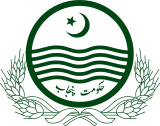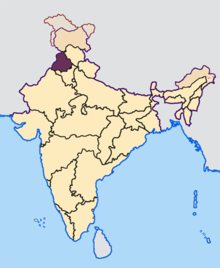Punjabi clothing
In the ancient Punjab region, people wore cotton clothing. The tops for both genders reached to the knees. A scarf was worn over the tops which would be draped over the left shoulder and under the right. A large sheet would be further draped over one shoulder which would hang loose towards the knees. Both sexes wore a dhoti around the waist.[1] Modern Punjabi dress has retained this outfit but over its long history has added other forms of dress.
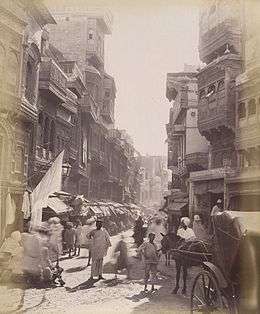
| Part of a series on the |
| Punjabis |
|---|
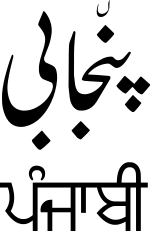 |
|
|
Asia
Europe North America Oceania |
|
Culture |
|
Punjab portal |
The Punjab region had a flourishing industry in cotton during the 19th and early 20th centuries, when various kinds of coarse cotton cloths including lungi, khes, datahi, chadders, coasting, shirting, curtains, susi, tehmats, durris, towels, dusters, patkas etc. were manufactured in Hoshiarpur, Gurdaspur, Peshawar, Lahore, Multan, Amritsar, Ludhiana, Jhang, Shahpur, Jalandhar, Delhi, Gurgaon, Rohtak, Karnal, Rewari, Panipat etc.[2] This cotton industry added to the richness of Punjabi clothing which exhibits Punjab's rich and vibrant culture in its dresses.[3][4] Various types of dresses are worn based on different Punjabi festivals, local events and ceremonies.
Along with different traditional dresses special types of ornaments are also very common.[5]
Suthan
The use of the suthan in the Punjab region also called suthana in Punjabi is a survival of the ancient svasthana.[6] Svasthana referred to a lower garment which can be described as a type of trousers. The svasthana was in use amongst the rulers in the Mauryan times(322–185 BCE),[7] amongst the ruling classes in North India during the Kushan Empire between the 1st and 3rd centuries C.E,[8] during the Gupta Empire between 4th and 6th centuries C.E.[9] and during King Harsha's[10] rule during the 7th century C.E.
The Punjabi suthan is a direct variation of the svasthana which can either be loose to above the ankles and tight around the ankles, or loose to the knees and tight to the ankles. The suthan is a male and female garment but its use is particularly important in the Punjabi suthan suit whereby it is worn by women with a kurti or kurta. It is also a part of the Punjabi ghagra outfit. Other variations include the choga (robe) and suthan combination.
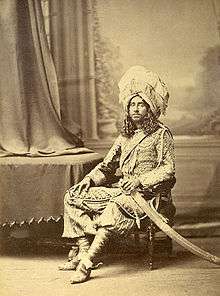 The Nawab Muhammad Bahawal Khan Abbasi V Bahadur (1883–1907) of Bahawalpur State in suthan
The Nawab Muhammad Bahawal Khan Abbasi V Bahadur (1883–1907) of Bahawalpur State in suthan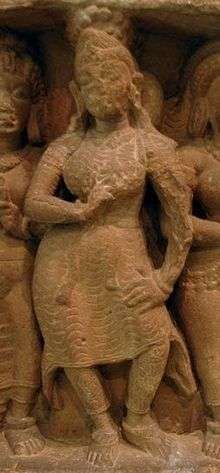 Ancient svasthana and varbana outfit worn during Gupta Empire, the basis of the Punjabi suthan suit
Ancient svasthana and varbana outfit worn during Gupta Empire, the basis of the Punjabi suthan suit Men in British Punjab army in tight and loose Punjabi suthans 1895
Men in British Punjab army in tight and loose Punjabi suthans 1895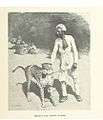 Man in tight Punjabi suthan. 1896
Man in tight Punjabi suthan. 1896 1893. Men in Punjabi tight from knees suthan
1893. Men in Punjabi tight from knees suthan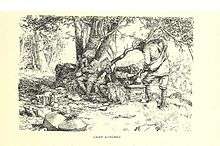 Men of the British Punjab army in Punjabi churidar suthans 1895 Punjab Hills
Men of the British Punjab army in Punjabi churidar suthans 1895 Punjab Hills
Kurta
The kurta with its side slits in the Punjabi kurta can be traced to the 11th century C.E.[11] female kurtaka worn in parts of north India. The kurtaka was a short shirt, with sleeves extending from the shoulders, to the middle of the body, and had slashes on the left and the right sides.[12] This is the same as the modern Punjabi kurta which has side slits and is worn by women in the Punjab region[13] as do men. The kurta also draws inspiration from the jama and the Punjabi angarkha. The kurta can be worn with a salwar, suthan, tehmat, lungi, dhoti, Punjabi ghagra and jeans.
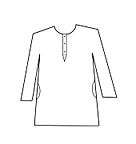 Kurta - Men's
Kurta - Men's- Man in Dhoti Kurta
 Man in blue kurta
Man in blue kurta- kurta
Multani kurta
The Multani kurta is crocheted using designs of Multan (Punjab, Pakistan).[14] Local Ajrak prints are also used.
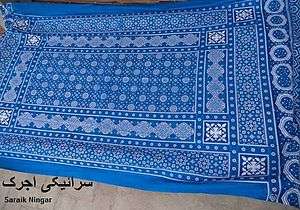 Saraiki Ajrak
Saraiki Ajrak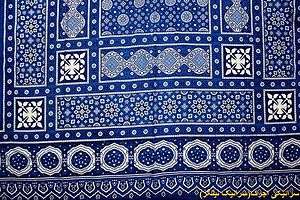 Saraiki Ajrak
Saraiki Ajrak
Punjabi phulkari kurta
A Phulkari kurta is embroidered using the Phulkari embroidery of the Punjab region.[15]
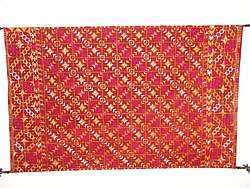 Patiala Phulkari
Patiala Phulkari Josephine Powell Collection, voor 1965: Phulkari kurta
Josephine Powell Collection, voor 1965: Phulkari kurta
Punjabi bandhani kurta
Bandhani tye-dyeing is popular in the Cholistan desert[16] area of the Punjab region. Bandhani patterns are used on kurtas.
- Rohi (Cholistan) woman's bandhani dress (Punjab, Pakistan)
Muktsari kurta
The traditional Punjabi kurta of the Punjab region is wide and falls to the knees[17] and is cut straight.[18] The modern version of the regional kurta is the Mukatsari kurta which originates from Muktsar in Punjab. This modern Punjabi kurta is famous for its slim fitting cuts and smart fit designs. It is very popular among young politicians.[19]
Salwar suit
The Punjabi suit is the traditional dress of women in the Punjab region. It is made up of a kurta or kameez and a straight cut salwar. In some parts of the Punjab region, men also wear the Punjabi suit.
The Punjabi suit is cut differently to the styles worn in Balochistan and Afghanistan[20] and is known as a "Punjabi suit"[21][22] with the kameez being cut straight and flat with side slits[23] (which is a local development as earlier forms of kameez did not have side slits).[24] The salwar is wide at the top but fits closely to the legs and is gathered at the ankles.[25] The Punjabi salwar is also cut straight and gathered at the ankles with a loose band reinforced with coarse material. In rural Punjab, the salwar is still called the suthan.[26] The Punjabi suit is popular in other regions of the subcontinent,[27][28] such as Mumbai and Sindh.[29] It is also popular in Afghanistan,[30] where it is called the Punjabi.[31]
- Men's Punjabi salwar suit
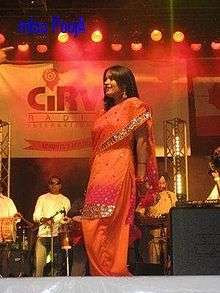 Punjabi suit
Punjabi suit Girls in Punjabi suits
Girls in Punjabi suits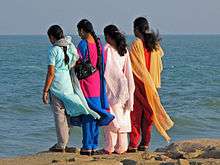 Women in Punjabi suits
Women in Punjabi suits.jpg) Dance, Attari-Wagah, women wearing Punjabi suits
Dance, Attari-Wagah, women wearing Punjabi suits
Punjabi Tamba and Kurta
The Punjabi version of the dhoti is known as Tehmat/Tamba or laccha. Whereas the tehmat is of one colour and has no border, the laacha has a border and is variegated so that it has more than one colour.[32]
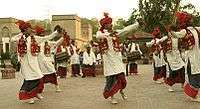 Bhangra Dance performers in Punjab wearing Kurta and Tehmat.
Bhangra Dance performers in Punjab wearing Kurta and Tehmat.
Kurti
In modern usage, a short kurta is referred to as the kurti. However, traditionally, the kurti refers to upper garments which sit above the waist without side slits, and are believed to have descended from the tunic of the Shunga period (2nd century B.C.).[33]
In the Punjab region, the kurti is a short cotton coat.[34] Another style of Punjabi kurti is a short version of the anga (robe).[35] The kurti can be worn by men but women wear it along with the Punjabi ghagra or suthan.
Pothohari suit
Another style of the Punjabi suit is the use of the salwar which hails from the Pothohar region of Punjab, Pakistan and is known as the Pothohari salwar.[1] The Pothohari salwar retains the wideness of the older Punjabi suthan and also has some folds. The kameez is also wide. The head scarf is traditionally large,[36] similar to the chador or Phulkari that was used throughout the plains of the Punjab region.[1]
Chola
The chola is a long outfit which is similar to a gown. It is worn by women and men and can reach the ankles,[37] or fall just below the knees. The traditional chola is closed by loops[38] and is tied on either shoulder and tends not to have side slits. The chola is the traditional alternative to other upper garments of the local region.[39] The modern chola opens at the front below the neck, is closed with buttons and may have side slits, and is worn like a kurta.[40] In Himachal Pradesh, the woolen waist band is called a dora.[41]
 Nightwatchman 1878. man in Punjabi chola and Punjabi ghutanna pajama
Nightwatchman 1878. man in Punjabi chola and Punjabi ghutanna pajama Men wearing modern chola
Men wearing modern chola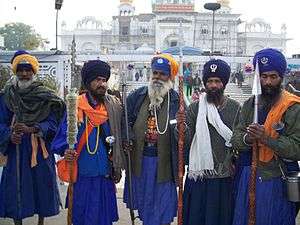 Group of men in cholas
Group of men in cholas
Choga
A choga is a long sleeved, skirted cloak that opens to the down front and is fastened above the waist.[42]
 Multani men in choga 1851
Multani men in choga 1851
Punjabi suthan suit
The Punjabi suthan[43] and kurta/kurti suit is an outfit with a very long history. The Punjabi suthan is a local variation of the ancient svasthana tight fitting trousers which have been used in the Punjab region since the ancient period[10][44] and was worn with the tunic called varbana[45] which was tight fitting.
The Punjabi suthan is arranged in plaits and uses large amounts of material (traditionally coloured cotton with vertical silk lines, called sussi)[46] of up to 20 yards hanging in innumerable folds.[47] The suthan ends at the ankles with a tight band[48][49] which distinguishes the suthan from a salwar.[1] Some versions of the Punjabi suthan tighten from the knees down to the ankles (a remnant of the svasthana). If a tight band is not used, the ends of the suthan fit closely around the ankles. The head scarf can be a wide chador, phulkari or modern dupatta/chunni.
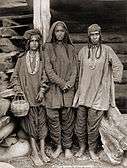 Women in Punjabi suthan 1890
Women in Punjabi suthan 1890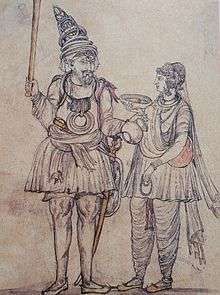 19th Century Punjabi suthan suit worn by the lady on the right
19th Century Punjabi suthan suit worn by the lady on the right Punjabi woman in Punjabi suthan and short kurta 1874
Punjabi woman in Punjabi suthan and short kurta 1874 Woman on right in loose Punjabi suthan suit
Woman on right in loose Punjabi suthan suit A Punjabi woman in Kurti and suthan visiting the Attar, the pharmacist. 1852
A Punjabi woman in Kurti and suthan visiting the Attar, the pharmacist. 1852 Punjab Hills 1895. Kulu woman in Punjabi churidar suthan. Himachal Pradesh.
Punjab Hills 1895. Kulu woman in Punjabi churidar suthan. Himachal Pradesh.
Punjabi ghagra
The Punjabi ghagra was the traditional apparel for women before the advent of the Punjabi suit.It is still worn in parts of the Punjab region and the outfit comprises the head scarf, kurta/kurti, suthan/salwar and the ghagra.
The ghagra has its origin in the candataka, which had become a popular garment in the Gupta period.[50] The candataka was a men's half trousers[51] which eventually developed into the ghagra. The intermediate formation has been described as a shirt like dress for men and women from the neck to the thighs.[52][53] Candataka continued as a popular female dress in the seventh century.[54]
- Statutes of women in kurta
- Saraiki Tradition women wearing ghagra Punjab, Pakistan
- Punjabi kurta and lehenga
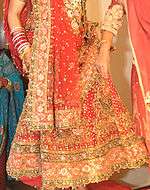 Bridal lehenga with Gota Embroidery
Bridal lehenga with Gota Embroidery
Punjabi Juti
The Punjabi Jutti is the Punjabi version of the shoe. Local styles include designs from Patiala,[55] the Pothohari shoe with sharp pointed toes, and the Derawali shoe with silk embroidery and round tipped.[56]
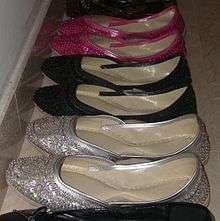 Jutti shoes
Jutti shoes Fazilka jutti
Fazilka jutti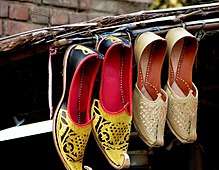 Punjabi jutti for men with extended curved tip, or nokh
Punjabi jutti for men with extended curved tip, or nokh
Patiala salwar
The Patiala salwar was developed in Patiala and is very popular with women.
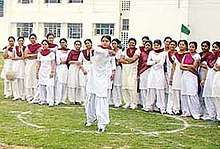 School girls wearing Patiala Salwar
School girls wearing Patiala Salwar
Saraiki shalwar suits
Saraiki shalwar suits are Punjabi outfits which include the Bahawalpuri shalwar suit and the Multani shalwar suit.
Bahawalpuri shalwar suit
The Bahawalpuri shalwar[57] originates from the Bahawalpur region of Punjab, Pakistan. The Bahawalpuri shalwar is very wide and baggy[58] with many voluminous folds.[59] The material traditionally used for the Bahawalpuri shalwar and suthan is known as Sufi which is a mixture of cotton warp mixed with silk weft and gold threads running down the material.[60] The other name for these types of mixed cloth is shuja khani.[61] The Bahawalpuri shalwar is worn with the Bahawalpur style kameez, the Punjabi kurta or chola.[62]
Multani shalwar suit
The Multani shalwar, also known as the 'ghaire wali' or 'Saraiki ghaire wali' shalwar as it is very wide around the waist, originates from the Multan area of the Punjab region. The style is similar to the Sindhi kancha shalwar as both are derivatives of the pantaloon shalwar worn in Iraq[65] and adopted in these locations during the 7th century A.D.[66][67][68] The Multani shalwar is very wide, baggy,[69] full and has folds like the Punjabi suthan.[70] The upper garments include the Punjabi kameez and the chola of the Punjab region.[71]
Fabric prints and embroidery
Block printing on cotton and other materials is popular in Multan which utilises local Ajrak prints. The other type of prints are known as chit Multani[72] or Multani chint.[73] Cholistan, Bahawalpur and Multan are known for its tie-dying material which is popular in this region.[74]
The emroidery styles of the Punjab region include the styles of Multani embroidery which features kalabatun[75] patterns using thin wires. This type of embroidery is also common in the rest of the Punjab region. Kalabatan surkh involves using gold wires on orange coloured and red silk. Kalabatan safed involves using silver wires on white material. There are two kinds of gold embroidery, one of a solid and rich kind called kar-chob and the other called tila-kar or kar-chikan utilising gold thread. The former is used for carpets and saddle cloths whereas the latter is used for dresses. The Punjab region also uses mukesh embroidery: mukesh bati-hui, twisted tinsel, mukesh gokru, flattened gold wire for embroidery of a heavy kind, and waved mukesh, made by crimping mukesh batihui with iron tongs.[76]
Ludhiana and Amritsar are known for embroidery using white, silver and gold threads on clothes such as chogas and waistcoats (phatuhi).[1] Kangra is known for the patterns embroidered on its handkerchiefs known as Kangra rumal. The designs include representations of religious stories.[1] These rumals are also embroidered in Chamba.
 Saraiki Ajrak
Saraiki Ajrak- Cholistan tye-dying
 Chamba Rumal with Scenes of Gopis Adoring Krishna
Chamba Rumal with Scenes of Gopis Adoring Krishna_LACMA_M.64.24.1.jpg) Head Cloth (Phulkari)
Head Cloth (Phulkari)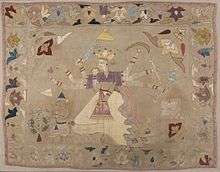 Chamba Rumal with Scenes of Sita and Hanuman
Chamba Rumal with Scenes of Sita and Hanuman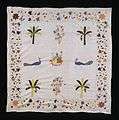 Chamba Rumal with Krishna and Radha
Chamba Rumal with Krishna and Radha
Phulkari
The Phulkari is the traditional Punjabi embroidery used to embroider shawls and head scarfs in the Punjab region.
Chaup and subar
The two styles of chaup and subar are worn by brides. The chaup is embroidered on both sides of the cloth. Only the borders and the four edges of the cloth are embroidered in fine embroidery.[1] The subar has a central motif and four motifs on the corners.[77]
Til patra
The til (sesame) patra has decorative embroidery which is spread out as if spreading sesame seeds.[1] The term til patra means 'the sprinkling of seeds'.
Neelak
The neelak phulkari is made of a black or red background with yellow or bright red embroidery. The colour of the phulkari is mixed with metals.[1]
Ghoonghat bagh
Originating in Rawalpindi, the ghoonghat bagh is heavily embroidered around the centre on the edge to be worn over the head. The embroidered centre is then pulled over the face so as to form an embroidered veil.[1]
Chhamaas
The chhaamas phulkari hails from Rohtak, Gurgaon, Hissar and Delhi. The chaamas phulkari incorporates mirrors which are sewn into the cloth with yellow, grey or blue thread.[1]
Phulkari of south and southwestern Punjab region
The phulkari of south and southwestern Punjab region, has wide edges upon which designs of animals and birds are embroidered. As is the case of the chaup, the edges are embroidered on both sides of the cloth.[1] South and southwestern Punjab region includes the south Punjab, India, south and south west of Punjab, Pakistan.
Senchi phulkari
The senchi phulkari is popular in and around Ferozepur. The senchi phulkai incorporates designs of birds, jewellery such as bracelets, earrings, rings and necklaces.[1]
 Phulkari from Patiala
Phulkari from Patiala%2C_Punjab%2C_early_20th_century%2C_cotton%2C_silk_and_embroidery%2C_Honolulu_Academy_of_Arts.jpg) 'Phulkari' (bridal shawl), Punjab, early 20th century, cotton, silk and embroidery, Honolulu Academy of Arts
'Phulkari' (bridal shawl), Punjab, early 20th century, cotton, silk and embroidery, Honolulu Academy of Arts- Phulkari from Punjab, India, 20th century, khadi, silk, plain weave, embroidery, Honolulu Museum of Art
- Bridal shawl (phulkari) from Punjab, khadi (hand-spun, hand-woven cotton), silk, plain weave, embroidery, Honolulu Museum of Art
Luanchari
Luanchari is a full-dress made of two parts stitched together: the upper part is the choli and the lower is the lehanga.[78] It is traditional garment worn by Gaddis of Himachal Pradesh.[78]
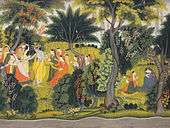 Pahari painting depicting women in Luanchari. ca.1760
Pahari painting depicting women in Luanchari. ca.1760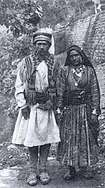 Himachal woman in Luanchari
Himachal woman in Luanchari
Punjabi ghuttana
The Punjabi ghuttana was popular with women and men in the Punjab region, a type of pajamma which is shorter than the full length pajamma, and is tight and ends at the calf.[79] Its variation is still worn in Jammu.
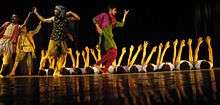 Men and boys wearing a knee length variation of the Punjabi ghuttana[80] and Dogri kurta. The full suthan is tight from the knees to the ankles
Men and boys wearing a knee length variation of the Punjabi ghuttana[80] and Dogri kurta. The full suthan is tight from the knees to the ankles
Churidar pajama
The use of the churidar is traditionally associated with the northern regions of the sub-continent. Although there is no consensus as to its origins, the churidar pajamma was adopted by the former princely families.[81] In the Punjab region however, its use was amongst the general population.
For people of the Punjab region, the churidar pajamma which forms part of the traditional attire of men and women in Punjab[82] is a combination of the tight suthan of the Punjab region, the churidar suthan of the Punjab's hill area, and the traditional Dogri suthan which ends in loose bangles (and is more of a loose pajamma as the suthan has to have a tight band at the ankles). Accordingly, the churidar pajamma is believed to be derived from the suthan. The Churidar is popular all over the sub-continent and was developed in the Punjab region, and is associated with the Punjab.[83][84] The churidar pajama can be of any colour but traditionally is of sussi (cotton) material, in blue with vertical stripes.[85]
The churidar pajama is also known as the (full length) ghuttana.[86] When soldiers from Lucknow travelled to the British Punjab province, they saw the long ghuttana pajama and adopted its use in Lucknow during the 19th century.
 Ancient form of salwar Kameez worn during Gupta Empire.
Ancient form of salwar Kameez worn during Gupta Empire.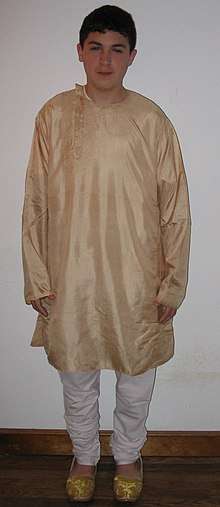 Cotton churidar worn with silk side-opening kurta and mojari shoes
Cotton churidar worn with silk side-opening kurta and mojari shoes Portrait of Kashmiri children wearing churidar pyjamas circa 1890
Portrait of Kashmiri children wearing churidar pyjamas circa 1890 Cotton churidar with cotton kurta and Khadi Nehru jacket
Cotton churidar with cotton kurta and Khadi Nehru jacket 19th century Indian women wearing transparent skirts over churidar pants
19th century Indian women wearing transparent skirts over churidar pants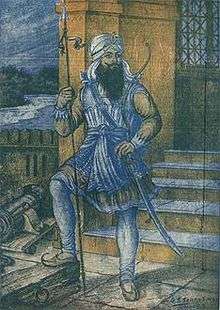 Jodh Singh Ramgarhia. 19th century.
Jodh Singh Ramgarhia. 19th century.
Jama
The jama was worn by men in the Punjab region during the Mughal period. The phrase "jora jama" refers to the clothes given by the maternal uncle to the groom,[87] which points to the jama being part of Punjabi clothing (although grooms do not wear the jama now). A local style of shawl called the jamawar which was striped was used as a gown.[88][89]
 The commander of the Imperial Guard of Delhi
The commander of the Imperial Guard of Delhi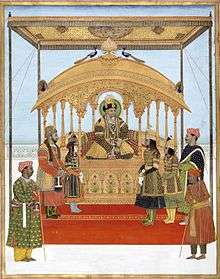 Ghulam Murtaza Khan The Delhi Darbar of Akbar II
Ghulam Murtaza Khan The Delhi Darbar of Akbar II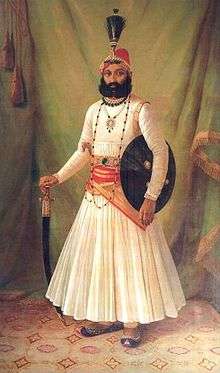 Raja Ravi Varma, Maharaja Fateh Singh
Raja Ravi Varma, Maharaja Fateh Singh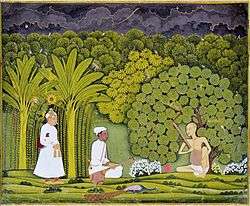 Akbar and Tansen visit Haridas
Akbar and Tansen visit Haridas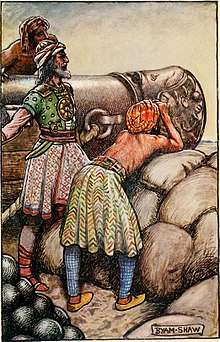 Mughal Army artillerymen during the reign of Akbar.
Mughal Army artillerymen during the reign of Akbar..jpg) Officer of the Mughal Army, c.1585 (colour litho)
Officer of the Mughal Army, c.1585 (colour litho)
Anga/Angarkha
The anga (robe) also known as an angarkha[90][91] and peshwaj)[92] is similar to a loose coat and wadded with cotton.[93] The anga can be worn by men and women. When worn by men, it falls to below the knees, is a loose tunic[94] and is fastened either to the right of the left.[95] An angarkha typically does not have front buttons.[96] Grooms traditionally wore the angarkha which has now been superseded by the achkan. The anga worn by women is a long robe.
.jpg) Ranjit Singh Equestrian in Saffron Robe
Ranjit Singh Equestrian in Saffron Robe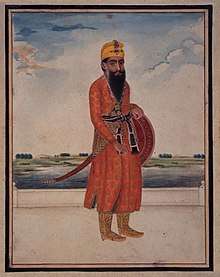 A watercolor portrait of Ranjit Singh who wore the angarkha during his reign.[97]
A watercolor portrait of Ranjit Singh who wore the angarkha during his reign.[97]
Chamba angarkhi
The Chamba angarkhi of Himachal Pradesh is sewen tight at the torso, but below the waist it has an open fall like the modern skirt. The angarkhi is tied at the waist with a sash.[98]
Turban
Men traditionally wear the turban. In the past, large turbans were worn such as the type in Bahawalpur which could be up to 40 feet long.[1] Now the turbans are shorter of various designs.
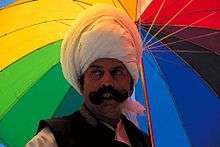 Malik Ata Muhammad Khan, Nawab of Kot Fateh Khan in Attock District, Punjab,Pakistan wearing a turban made from 6.4 metres (7.0 yards) of cloth
Malik Ata Muhammad Khan, Nawab of Kot Fateh Khan in Attock District, Punjab,Pakistan wearing a turban made from 6.4 metres (7.0 yards) of cloth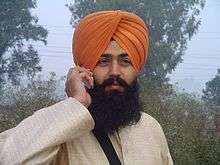 A dastar
A dastar- Patiala Shahi Turban
.jpg)
- Saraiki Turban (West Punjab)
Saluka
The saluka is a tight fitting waistcoat which was worn in Sindh and the Punjab region.[99] It is also worn in Uttar Pradesh.
See also
- Saraiki shalwar suits
- Sindhi dress
- Jammu dress
- Perahan tunban
- Firaq partug
- Khet partug
- Phiran
- Pakistani clothing
- Clothing of Balochistan, Pakistan
- Khyber Pakhtunkhwa clothing
References
- Mohinder Singh Randhawa. (1960) Punjab: Itihas, Kala, Sahit, te Sabiachar aad.Bhasha Vibhag, Punjab, Patiala.
- Parshad, Gopal (2007) Industrial development in Northern India: a study of Delhi, Punjab and Haryana, 1858-1918
- "Punjabi Dressing". Coloursofpunjab.com. Archived from the original on 2015-05-03. Retrieved 2015-05-17.
- "Baisakhi Dress,Bhangra Dress,Gidda Dress,Dress for Baisakhi Festival". Baisakhifestival.com. Retrieved 2015-05-17.
- "Traditional Dresses of Punjab | Traditional Punjabi Attire". Discoveredindia.com. Retrieved 2015-05-17.
- Catherine Ella Blanshard Asher, Thomas R. Metcalf (1994) Perceptions of South Asia's visual past
- Viishnu Asha (1993) Material Life of Northern India: Based on an Archaeological Study, 3rd Century B.C. to 1st Century B.
- Archaeological Congress and Seminar Papers: Papers Presented at the 4th Annual Congress of the Indian Archaeological Society and the Seminars Held at Nagpur on the 10th, 11th, and 12th Nov. 1970, Volume 4, Part 1970
- Mohapatra, Ramesh Prasad (1992) Fashion Styles of Ancient India: A Study of Kalinga from Earliest Times to Sixteenth Century Ad
- A. V. Narasimha Murthy, K. V. Ramesh (1987) Giridharaśrī: essays on Indology : Dr. G.S. Dikshit felicitation volume
- Ghurye, Govind Sadashiv (1966) Indian Costume
- Yadava,Ganga Prasad (1982) Dhanapāla and His Times: A Socio-cultural Study Based Upon His Works
- Sharma, Brij Narain (1966) Social life in Northern India, A.D. 600-1000
- Official Journal of the European Communities: Legislation, Volume 30, Issues 248-256 (1987)
- Naik, Shailaja D. (1996( Traditional Embroideries of India
- Nasreen Askari, Liz Arthur, Paisley Museum and Art Galleries Merrell Holberton, (1999) Uncut cloth
- Punjab District Gazetteers: Attock district, 1930. Printed 1932
- Asoke Kumar Bhattacharyya, Pradip Kumar Sengupta (1991) Foundations of Indian Musicology: Perspectives in the Philosophy of Art and Culture
- Puneet Pal Singh Gill (04.01.2012) The Chandigarh Tribune Muktsari-style kurta pyjama a fad
- Jānmahmad (1982) The Baloch cultural heritage
- Tannaaz Irani (2014) The Armchair Critic: Chafes and Chuckles
- Marwaha, Pritpal (2012) Shakahaari: The Vegetarian Gourmet Fine, Authentic Indian Vegetarian Cuisine
- Cooke, David Coxe (1967) Dera, a village in India
- Mohsen Saeidi Madani (1993)Impact Of Hindu Culture On Muslims
- Kumar, Raj (2006) Paintings and Lifestyles of Jammu Region: From 17th to 19th Century A.D
- Panjab University Research Bulletin: Arts, Volume 13, Issue 1 - Volume 14, Issue (1982)
- Sorabji M. Rutnagur (1996) The Indian Textile Journal, Volume 106, Issues 9-12
- McGilvray, Dennis B. (2008)Crucible of Conflict: Tamil and Muslim Society on the East Coast of Sri Lanka
- Bakshi, SHri Ram (1992) Struggle for Independence: Vijaya Lakshmi Pandit
- Culture and Customs of Afghanistan By Hafizullah Emadi
- Afghanistan Culture
- Punjab District Gazetteers - Gujranwala District Year Published 1935
- Panjab University Research Bulletin: Arts, Volume 13, Issue 1 - Volume 14, Issue (1982)
- Punjab District Gazetteers: Rawalpindi District (v. 28A) (1909)
- Compiled and published under the authority of the Punjab government, (1939)Punjab District and State Gazetteers: Part A].
- Culture and Traditions of Kashmir
- Flynn, Dorris Flynn (1971) Costumes of India
- Punjab district gazetteers, Volume 7, Part 1 Multan (1923)
- Punjab District Gazetteers: Shahpur district, rev. ed 1897
- Khalid, Haroon (2013) A white trail: A journey into the heart of Pakistan's religious minorities
- Chaudhry, Minakshi (2006) Himachal: A Complete Guide to the Land of Gods
- Lewandowski, Elizabeth J. (2011) The Complete Costume Dictionary
- Haryana District Gazetteers: Sirsa (1988)
- Aniruddha Ray, Kuzhippalli Skaria Mathew (2002) Studies in history of the Deccan: medieval and modern : Professor A.R. Kulkarni felicitation volume
- J. J. Bhabha (1969) Mārg̲, Volume 23 Marg Publications (1969)
- Punjab District Gazetteer: Reprint of Ludhiana District and Malerkotla State Gazetteer, 1904
- Punjab District Gazetteers (1932)Punjab District Gazetteers (1932)
- Punjab revenue dept.(1876) Land revenue settlement reports
- Census of India, 1961, Volume 20, Part 6, Issue 9. Himachal Pradesh
- Subbarayappa, B. V. (1985) Indo-Soviet Seminar on Scientific and Technological Exchanges Between India and Soviet Central Asia in Medieval Period, Bombay, November 7–12, 1981: Proceedings
- Bose, Mainak Kumar (1988) Late classical India
- Gupta, Dharmendra Kumar (1972) Society and Culture in the Time of Daṇḍin
- Chandra, Moti (1973) Costumes, Textiles, Cosmetics & Coiffure in Ancient and Mediaeval Indi
- Uma Prasad Thapliyal (1978) Foreign elements in ancient Indian society, 2nd century BC to 7th century AD
- The Panjab Past and Present, Volume 36 (2005)
- Punjab District Gazetteers Mianwali District 1916
- The Pakistan gazetteer, Volume 5 (2000)
- Current Opinion, Volume 25 (1899)
- Katherine Prior, John Admson (2001) Maharajas' Jewels
- Extracts from the District & States Gazetteers of the Punjab, Pakistan, Volume 2 (1976)
- The Pakistan gazetteer, Volume 3 (2000)
- 1998 District Census Report of [name of District].: Lodhran (1999)
- The Pakistan gazetteer, Volume 5 (2000)
- The All-Pakistan Legal Decisions, Volume 36, Part 1 1984
- Islamic Culture: The Hyderabad Quarterly Review, Volumes 41-43 (1979)
- Kumar, Raj (2008) Encyclopaedia of Untouchables Ancient, Medieval and Modern
- Sawindara Siṅgha Uppala (1966) Panjabi short story: its origin and development
- Chandra, Moti (1973) Costumes, Textiles, Cosmetics & Coiffure in Ancient and Mediaeval India
- Chaudhry, Nazir Ahmad (2002) Multan Glimpses: With an Account of Siege and Surrender
- Glossary of the Multani Language, Or, Southwestern Panjabi (1903)
- O'Brien, Edward (1881) Glossary of the Multani Language Compared with Punjábi and Sindhi
- Baden-Powell, Baden Henry (1872) Hand-book of the Manufactures & Arts of the Punjab: With a Combined Glossary & Index of Vernacular Trades & Technical Terms ... Forming Vol. Ii to the "Hand-book of the Economic Products of the Punjab" Prepared Under the Orders of Government
- Parliamentary Papers, House of Commons and Command, Volume 25 (1859)
- Sarina Singh, Lindsay Brown, Paul Clammer, Rodney Cocks (2008) Pakistan and the Karakoram Highway
- Ramananda Chatterjee (1939) The Modern Review, Volume 66, Issues 1-6
- Baden-Powell, Baden Henry (1872)Hand-book of the Manufactures & Arts of the Punjab: With a Combined Glossary & Index of Vernacular Trades & Technical Terms ... Forming Vol. Ii to the "Hand-book of the Economic Products of the Punjab" Prepared Under the Orders of Government
- Naik, Shailaja D. (1996) Traditional Embroideries of India
- Textiles, Costumes, and Ornaments of the Western Himalaya - Omacanda Hāṇḍā - Google Books. Books.google.co.in. Retrieved 2013-10-25.
- Paintings and lifestyles of Jammu Region: 17th to 19th Century A.D Raj Kumar
- Kumar, Ritu (2006) Costumes and textiles of royal India
- Pakistan Quarterly, Volumes 8-9 (1958)
- Kehal, Harkesh Singh. Alop ho riha Punjabi Virsa. Unistar Books PVT Ltd ISBN 978-93-5017-532-3
- The Grace of Four Moons: Dress, Adornment, and the Art of the Body in Modern India (2013)
- Kumar, Raj. Paintings and Lifestyles of Jammu Region: From 17th to 19th Century A.D
- Macfarquhar, A. Punjab District Gazetteers - Amritsar District Year Published 1947
- Abdul Halim Sharar, Rosie Llewellyn-Jones, Veena Talwar Oldenburg (2001) The Lucknow Omnibus
- Hershman, Paul (1981) Punjabi kinship and marriage
- Sir Watt, George (1903) Indian Art at Delhi 1903: Being the Official Catalogue of the Delhi Exhibition 1902-1903
- Baden Henry Baden-Powell (1872) Hand-book of the Manufactures and Arts of the Punjab
- Rajaram Narayan Saletore (1974) Sex Life Under Indian Rulers
- Panjab University Research Bulletin: Arts, Volume 13, Issue 1 - Volume 14, Issue 1 (1982)
- B. N. Goswamy, Kalyan Krishna, Tarla P. Dundh (1993) Indian Costumes in the Collection of the Calico Museum of Textiles, Volume 5
- Punjab District Gazetteers - District Attock Year Published 1930 BK-000211-0160
- Punjab District Gazetteers: Ibbetson series, 1883-1884].
- Punjab gazetteers, 1883, bound in 10 vols., without title-leaves
- Hankin, Nigel B. (2003) Hanklyn-janklin
- Gupta, Hari Ram (1991) History of the Sikhs: The Sikh lion of Lahore, Maharaja Ranjit Singh, 1799-1839
- Kamal Prashad Sharma, Surinder Mohan Sethi (1997) Costumes and Ornaments of Chamba
- Govind Sadashiv Ghurye (1951) Indian costume: (bhāratīya vesabhūsā)
